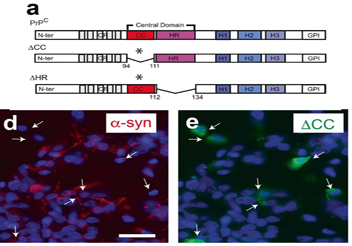New therapeutic target that could slow Parkinson’s progression
A team of researchers of the Institute of Neurosciences of the University of Barcelona and the Institute for Bioengineering of Catalonia (IBEC) have identified a possible mechanism to slow the neurodegenerative progression of Parkinson’s disease.
Parkinson’s neuronal degeneration is caused by Lewy bodies, abnormal aggregates created inside neurons with an altered version of α-sunyclein, a protein found in neurons’ cytoplasm. The key factor of the study, published in the journal Molecular Neurobiology, is the cellular prior protein (PrPc), a specialized molecule in the membranes of neurons which could be considered a therapeutic target to slow the progression of these pathologies.
“We clearly saw how α-sunyclein is able to move from a brain area to others, leaving a large amount of dead neurons and others left dying” says Laura Urrea, first author of the study and researcher at the Department of Cell Biology, Physiology and Immunology, the Institute of Neurosciences of the UB, and IBEC.
 According to the coordinator of the study, José Antonio del Río, professor from the mentioned Department and Institute, and main researcher of the group of Molecular and Cellular Neurobiology of IBEC, “PrPc is a key element for the spreading of Lewy bodies. If we could prevent these accumulations from grouping and propagating, we could stop the progression of neuronal death in diseases such as Parkinson”.
According to the coordinator of the study, José Antonio del Río, professor from the mentioned Department and Institute, and main researcher of the group of Molecular and Cellular Neurobiology of IBEC, “PrPc is a key element for the spreading of Lewy bodies. If we could prevent these accumulations from grouping and propagating, we could stop the progression of neuronal death in diseases such as Parkinson”.
The study also counts with the participation of experts from the Faculty of Medicine and Health Sciences of the University of Barcelona, and the Biomedical Research Networking Center on Neurodegenerative Diseases (CIBERNED), among other institutions.
Publication:
Urrea L.; Segura-Feliu M.; Masuda-Suzukake M.; Hervera A.; Pedraz L.; Aznar J.; Vila M.; Samitier J.;Torrents E.; Ferrer I.; Gavín R.; Hagesawa M.; del Río J (2017) «Involvement of Cellular Prion Protein in α-Synuclein Transport in Neurons» Molecular Biology, 1-14. Doi: 10.1007/s12035-017-0451-4



No Comments